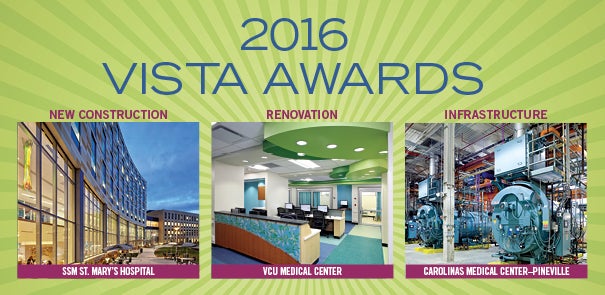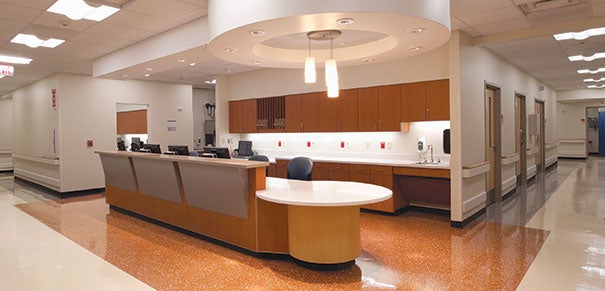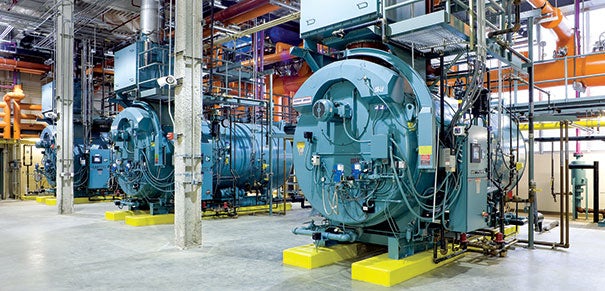2016 Vista Award winners

To be successful, health care design and construction projects require outstanding contributions from facility owners, architects, engineers and builders. In recognition of this fact, each year the American Hospital Association’s American Society for Healthcare Engineering (ASHE) presents the Vista awards for exceptional teamwork in the completion of new construction, renovation and infrastructure projects for health care.

View "2016 Vista Award winners" Gallery
Health Facilities Management congratulates this year’s winning projects: SSM St. Mary’s Hospital–Jefferson City (Mo.); the emergency department (ED) expansion and renovation at VCU Health’s (formerly Virginia Commonwealth University Health System’s) VCU Medical Center, Richmond, Va.; and the energy plant at Carolinas HealthCare System’s Carolinas Medical Center (CMC)–Pineville, Charlotte, N.C.
“Cooperation is a conscious decision,” says Leslie L. Hanson, AIA, principal and senior vice president in the Richmond office of HKS Inc., architecture firm on the VCU Health ED expansion and renovation project team. “We started off the project talking about how your own organization doesn’t win unless others win, and the success of the project depends upon us all helping each other,” she says. “Everyone rose to the challenge in a variety of ways. If you have that inherent trust and you’re going to care for one another, then you really can go a long way.”
C. Scott Shipp, PE, vice president in the Charlotte, N.C., office of RDK Engineers Inc. and principal in charge of CMC’s Pineville energy plant project, says his team is “very happy to have been selected” for a Vista award. “There are a lot of great projects around the United States, so when yours is chosen, it’s quite an honor,” he says.
Amy Eagle is a freelance writer based in Homewood, Ill., who specializes in health care-related topics. She is a regular contributor to Health Facilities Management.
NEW CONSTRUCTION WINNER

In creating a new medical center about 5 miles from the site SSM Health St. Mary’s Hospital, Jefferson City, Mo., had called home for 108 years, the project team says it sought to “enhance, preserve and transfer the St. Mary’s experience.” The new campus provides a state-of-the-art environment in which to further the hospital’s legacy of caregiving.
The new hospital has 172 private patient rooms; these include 122 medical-surgical rooms, 20 behavioral health inpatient rooms, 14 labor/delivery/recovery/postpartum suites, 12 intensive care rooms and four intensive care flex rooms. There are 26 emergency department (ED) exam rooms, including three behavioral health safe rooms. In addition, the hospital features 11 imaging rooms and seven operating suites, plus a shelled suite for future use. A medical office building and outpatient treatment center with several specialty clinics and services completes the campus.
In 2009, after the team had been selected but prior to the end of the planning and programming phase, the project was placed on hold. During the hiatus, the team held what they called “restart project meetings.” These meetings served to remind project participants and end users about work already completed and to inform them about upcoming phases.
“I can’t overemphasize the importance of that exercise,” says Mike Bock, the hospital’s director of facilities. “When the project was put on hold, everyone’s hearts just sunk to their feet. But we kept moving forward.” Due to this effort, when the project restarted in 2011 with a revised timeline, team members were able to resume their work with little loss of momentum, he says.
The project was completed two months ahead of schedule and more than 5 percent below budget, despite the addition of a strategic program not included in the initial plan. “That was a huge undertaking, to get ahead of schedule, but it made a major difference,” says Bock. Completing the project in November meant the hospital did not have to move patients in winter, when Missouri weather can be treacherous and the patient census is traditionally at its height.
Because the site is located in a previously undeveloped area at the edge of the city, the team had to coordinate with state and local governmental bodies and local utility companies to develop the infrastructure required for the campus. This included a new highway interchange, new roads, a new well and new electrical and natural gas services. In addition to these partnerships, the team worked to engage local subcontractors, ultimately achieving 70 percent local subcontractor participation. “It really was a community project,” says Bock.
Since the new facility opened, the numbers of admissions, patient days, ED visits and births at the hospital have all gone up compared with those of the previous year. HCAHPS and Press Ganey survey scores show significant improvements in several areas.
“We’re just thrilled to see those scores increase,” Bock says. “It’s been nothing but positive.”
PROJECT INFO
FACILITY: SSM Health St. Mary’s Hospital
LOCATION: Jefferson City, Mo.
SQUARE FEET: 432,000 (366,000 hospital, 66,000 medical office building)
NUMBER OF BEDS: 172
PROJECT BUDGET: $218 million
ACTUAL COST: $202 million
START DATE: April 2012
PROJECTED COMPLETION DATE: January 2015
ACTUAL COMPLETION DATE: November 2014
TEAM MEMBERS
BRENT VANCONIA, president and CEO, SSM Health St. Mary’s Hospital, Jefferson City, Mo.
MIKE BOCK, director of facilities, SSM Health St. Mary’s Hospital, Jefferson City, Mo.
TIM GUNN, vice president of construction, construction project director, Alberici Healthcare, St. Louis
KEVIN STUDER, principal, program manager, project director, Northstar Management, St. Louis
MICHAEL SCHNAARE, principal, architect principal in charge, Lawrence Group, St. Louis
DANIEL C. OAKLEY, associate, project manager, Heideman Associates Inc., Fenton, Mo.
RENOVATION WINNER

The expansion and renovation of the emergency department (ED) at Virginia Commonwealth University Medical Center in Richmond was a phenomenally complex project that touched on nearly every aspect of emergency medicine. The new Level I trauma center is a service of VCU Health (formerly Virginia Commonwealth University Health System).
The renovated and expanded space includes areas designed specifically for trauma, pediatric, geriatric, bariatric, behavioral health, department of corrections, sexual abuse, critical care, infectious disease, decontamination and observation patients. The project netted the medical center 98 total ED exam spaces, a gain of 26 more spaces than previously available at the facility.
The expansion and renovation were completed in four phases that were carefully planned to allow the existing ED to remain fully operational throughout the project, during which the entire ground floor of the hospital was renovated in place.
Phase 1 involved the construction of a separate pediatric ED with a dedicated entry and was designed with the goal of providing care with no wait time. This area features an imaging room and 12 exam rooms with bedside registration.
For the Phase 2 renovation, an 18-bed observation unit was developed that includes six rooms for geriatric patients, one sexual abuse nurse exam room, two decontamination rooms, a new entrance for ambulance traffic, a security station and clinical support spaces.
Areas renovated in Phase 3 included an imaging suite, a four-room security care unit for the local department of corrections, a five-room behavioral health unit and a satellite pharmacy.
In Phase 4, space was renovated to create a large, open trauma room with six trauma bays and four treatment/step-down bays. This phase also included the construction of 38 exam rooms, 10 results waiting spaces and a stat lab. The trauma room has the surge capacity to expand to nine trauma bays in the event of a mass casualty situation and the flexibility to expand to 11 bays in the future. The results waiting area can be used to diagnose or treat five patients if all other exam rooms are full. The 38 exam rooms include six rooms for critical care patients, two rooms for bariatric patients and four negative pressure rooms.
A post-occupancy evaluation shows a number of improvements in the functional performance of the ED, now that the project is complete. Staff turnover in the adult ED has dropped by 36 percent. The installation of handrails in exam rooms led to a reduction in the number of patient falls, with no falls attributed to the building. And, now that the trauma center is directly adjacent to computed tomography equipment, the average time to administer clot-busting medication (tissue plasminogen activator, or tPA) to stroke patients is less than 30 minutes.
“You think about how it’s going to make a difference in patients’ and families’ lives, and it’s amazing,” says Leslie L. Hanson, AIA, architectural principal in charge, from the Richmond office of HKS Inc.
PROJECT INFO
FACILITY: Virginia Commonwealth University Medical Center
LOCATION: Richmond, Va.
SQUARE FEET: 1,300 addition; 48,000 renovation; 17,900 shell space infill
NUMBER OF BEDS: 98 total exam rooms
PROJECT BUDGET: $37 million
ACTUAL COST: $35.6 million
START DATE: March 2010
PROJECTED COMPLETION DATE: June 2013
ACTUAL COMPLETION DATE: August 2013
TEAM MEMBERS
JOSEPH P. ORNATO, M.D., FACP, FACC, FACEP, professor and chairman, department of emergency medicine, owner project director, Virginia Commonwealth University Medical Center, Richmond
ROBERT REARDON, chief facility officer, project executive, VCU Health (formerly Virginia Commonwealth University Health System), Richmond
LESLIE L. HANSON, AIA, principal and senior vice president, architectural principal in charge, HKS Inc., Richmond, Va.
MATT WOOD, CHC, senior director, contractor, Barton Malow Co., Charlottesville, Va.
DAVID WRIGHT, PE, vice president, MEP engineer, ccrd partners, Richmond, Va.
C. NELSON WILLIAMS IV, PE, SECB, treasurer, structural engineer; Dunbar, Milby, Williams, Pittman & Vaughan; Richmond, Va.
INFRASTRUCTURE WINNER

The new central energy plant at Carolinas HealthCare System’s Carolinas Medical Center–Pineville, Charlotte, N.C., was designed and built to enable the health facility to transition from a community hospital to a major tertiary care and full-service medical campus.
Because of rapid population growth in the area, the health system saw a need for expanded services, including a new bed tower, surgical services wing, extended maternity care and other support services. Beyond increasing the capacity of the hospital, the expansion was seen as a way to attract specialized physicians and programs, such as radiation and surgical oncology, neurosurgery, robotic surgery and advanced cardiopulmonary care.
As C. Scott Shipp, PE, principal in charge of the project from the Charlotte office of RDK Engineers Inc. explains, “The more critical and the more acute care they’re providing, the more robust the energy plant and infrastructure need to be. You can’t afford downtime when you’re taking care of people who are having a heart-lung replacement, or a neurological operation for an aneurysm. Your infrastructure has to be on point 24/7.” Equally important, he says, are redundant systems that can maintain hospital services under almost any circumstance, especially for patients whose conditions do not allow them to be transferred to another location.
To make way for construction of the bed tower and surgical services expansion, the existing energy plant, which was located in the middle of campus, had to be demolished. The new, larger plant was built at the back of the campus. The energy plant project team worked extensively with hospital staff to ensure no interruptions to clinical services throughout the intricate transition from the old plant to the new plant. They also integrated their work schedules with the other design and construction teams on campus. “We had multiple projects with multiple construction managers and multiple design firms all working on the campus at the same time. It’s like building a big puzzle, and you have the pieces that you have, and the other teams have their pieces, and at the end of the day everything has to work together,” Shipp says.
The new plant, designed to operate unmanned (it can be monitored remotely from Carolinas HealthCare System’s nearby flagship campus), is more efficient than the previous plant from both a staffing and sustainability standpoint. With N+1 redundant systems, it is also more resilient to severe weather or other catastrophes. And, it is designed for easy future expansion, to allow the medical center to continue to grow without major interruption to its infrastructure. “We are very passionate about providing best-practice solutions for our health care clients,” says Shipp. “When we’re able to do projects like this, collaborating with other design teams to make it happen, it’s very satisfying.”
PROJECT INFO
FACILITY: Carolinas Medical Center–Pineville
LOCATION: Charlotte, N.C.
SQUARE FEET: 22,000 in central energy plant, 4,000 in hospital
NUMBER OF BEDS: 206
PROJECT BUDGET: $38 million
ACTUAL COST: $37.5 million
START DATE: June 2008
PROJECTED COMPLETION DATE: June 2010
ACTUAL COMPLETION DATE: January 2011
TEAM MEMBERS
ZACHARY ZAPACK, senior vice president, CHS administrative representative, Carolinas HealthCare System Administration, Charlotte, N.C.
C. SCOTT SHIPP, PE, vice president, principal-in-charge, RDK Engineers Inc., Charlotte, N.C.
DAVID A. WRIGHT, AIA, managing principal, principal-in-charge, Wright McGraw Beyer Architects, Charlotte, N.C.
TERRY JOHNSTON, senior vice president, principal-in-charge, Rodgers Builders Inc., Charlotte, N.C.
LARRY LOCKHART, PE, managing partner, civil engineering, Bloc Design (work completed while at ColeJenest & Stone), Charlotte, N.C.
JERRY MERWIN, CHFM, director of health care operations, energy plant manager, Win-Sam Inc., Fort Worth, Texas




